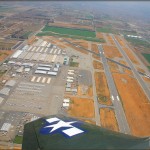 In the field of Aviation Photography, I’ve had some pretty amazing experiences. I’ve gotten to not only see some of the world’s rarest and most famous historical aircraft fly along side me during air-to-air shoots, but I’ve also had chances to ride in some warbirds as well which served as camera ships for shoots. Air-to-Air photography is a special type of photography, where you get to capture aircraft in their prime as they should be captured! I’ve had the chance to fly in various parts of a World War 2 era North American B-25 Mitchell medium bomber, which in itself is an adventure and experience all on it’s own with the cramped space to move around. But the views are spectacular. But no matter how much fun that is, there’s nothing life getting a flight in the backseat of a World War 2 fighter cruising all over Southern California.
In the field of Aviation Photography, I’ve had some pretty amazing experiences. I’ve gotten to not only see some of the world’s rarest and most famous historical aircraft fly along side me during air-to-air shoots, but I’ve also had chances to ride in some warbirds as well which served as camera ships for shoots. Air-to-Air photography is a special type of photography, where you get to capture aircraft in their prime as they should be captured! I’ve had the chance to fly in various parts of a World War 2 era North American B-25 Mitchell medium bomber, which in itself is an adventure and experience all on it’s own with the cramped space to move around. But the views are spectacular. But no matter how much fun that is, there’s nothing life getting a flight in the backseat of a World War 2 fighter cruising all over Southern California.
Ever since I saw the two World War 2 era North American P-51D Mustangs roar overhead near the climax of the amazing Steven Spielberg/Tom Hanks movie Saving Private Ryan (1998), 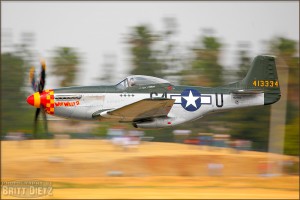 I’ve had this immediate ‘love at first sight’ with the famous fighter. I couldn’t want to see one in real life, much less see flying in person. I’m sure I had seen one at some point at one of the many MCAS El Toro Airshows, but at that time I was much more of a modern jet fan and the USN Blue Angels were on the highest throne for me. Since I joined the WW2 aviation fan party late in the game, MCAS El Toro was closed and my options for seeing a P-51 was reduced. Still though, I kept my ear open for any local Airshows I could attend hoping that a P-51 Mustang might show up. It took a few years (at the time I didn’t know about many of the local Air Museums that had events and airshows), but in 2001 I was finally able to see one in person at the Planes of Fame Air Museum.
I’ve had this immediate ‘love at first sight’ with the famous fighter. I couldn’t want to see one in real life, much less see flying in person. I’m sure I had seen one at some point at one of the many MCAS El Toro Airshows, but at that time I was much more of a modern jet fan and the USN Blue Angels were on the highest throne for me. Since I joined the WW2 aviation fan party late in the game, MCAS El Toro was closed and my options for seeing a P-51 was reduced. Still though, I kept my ear open for any local Airshows I could attend hoping that a P-51 Mustang might show up. It took a few years (at the time I didn’t know about many of the local Air Museums that had events and airshows), but in 2001 I was finally able to see one in person at the Planes of Fame Air Museum.
Before I get too far ahead of myself, I’ll talk about what a P-51 Mustang is.

A rare A-36A Apache
In 1939 the world was at war. With the invasion of Poland by Hitler and the German forces in September of that year, the British Royal Air Force found themselves in the gun sights of Hitler and his Luftwaffe. Thanks to the purchasing commission deal with the United States, the RAF approached North American Aviation company to build them licensed Curtiss P-40 Warhawks that they could use for defense. At the time, North American was already building T-6 Texans (named Harvards by the British) for the RAF. Knowing the time it would take to set up production of the P-40 would take time, North American Aviation offered to build an entirely new aircraft with the same engine (an Allison engine) for them that wouldn’t require a redo of the production facility and could get the aircraft out to the RAF in a much faster time. After given the approval, work began on an aircraft code named NA-73X, but there was one requirement given to North American from the RAF: the aircraft had to finish a working prototype in 120 days. Amazingly, it only took 117 days to develop the aircraft from design to prototype, minus the engine, which was an amazing feat. A few months later, the first prototype took to the air in October of 1940. The United States Army Air Corps (USAAF) kept a close eye on things and asked for two free test examples, their only requirement for letting the RAF have this fighter from an American company.
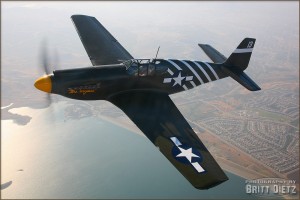
North American P-51A Mustang
While many grew excited about the prospect of this fighter, it soon became very clear during trials that the early Mustang’s performance was limited. At altitudes over 15,000 feet, the Mustang’s power and performance dropped considerably. To give you an idea of that range, most airliners travel at about 30,000 feet. While that was a significant downside, the early Mustang out performed the P-40 Warhawk and the Spitfire models that existed at the time. In September 1940, more Mustangs were ordered by the RAF. At this time was when the Mustang got it’s name. The USAAF had designated the NA-91 as the Apache, but the name was dropped in favor of the British name for the aircraft; The Mustang. In 1942, the USAAF ordered 1,200 P-51As for ground attack purposes, still unimpressed with the higher altitude performance of the Mustang. It was also during this year that the true potential of the Mustang was born. In April of 1942, after testing the Mustang during a series of trial flights, the Rolls Royce engine company realized that they could improve the Mustang’s potential by adding one of their supercharger engines, an engine named the Merlin. Several Mustangs were modified and fitted with these Merlin engines, and the legend was born.
The performance increase by adding the Merlin engines was so much that the same speeds achieved at 10,000 feet could be achieved, if not surpassed greatly, at 30,000 feet! Immediately orders came in for the Mustang with the Merlin engines, and the development of the Mustang continued adding drop tanks for much more fuel range allowing the P-51 Mustang to escort bombers deep inside of Germany. After the P-51B and P-51C models, the last remaining complaint was about the visibility of the P-51 when flying it.
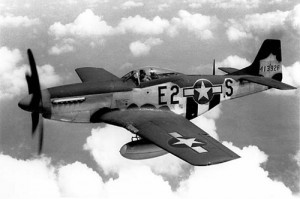
World War 2 P-51D Mustang Photo
You couldn’t look behind you, because the canopy turned into the fuselage in what’s called a ‘razor back,’ so if you had an enemy fighter on your tail you couldn’t see it. The final solution came in the P-51D Mustang model, a ‘teardrop’ or ‘bubble’ canopy. This allowed for a 360 degree unobstructed view around the P-51, and now finally the iconic image of the P-51 Mustang took center stage in Europe. Most of the success of daylight bombing raids into Europe by the 8th Air Force was due in fact to the escorting capabilities of the P-51D Mustang and it’s long range to be able to stay with the bombers all the way to the target. While other fighters would have to turn back and head home because of fuel limits leaving the bombers to defend themselves, the Mustang fitted with drop tanks could easily escort bombers to Germany and back. 7,954 P-51D Mustangs were produced during World War 2, the most of any Mustang variation. The P-51D Mustang had three Browning .50 Caliber machine guns in either wing (six total) and had a max speed of 437 miles an hour with a max range of 2,300 miles. 14,819 Mustangs were built in total (all versions) for the US Army Air Forces which went on to destroy some 4,950 Axis aircraft during World War 2 in Europe.
P-51s continued to serve well after World War 2, providing air support in the 1950s Korean War acting as a ground attack and even tangling with some MiG fighter jets. In 1947, the US Army Air Force became known as the US Air Force, splitting off from the US Army into it’s own branch.  The next year, the designation of Pursuit (IE P-51) became Fighter, so the P-51 became the F-51. The F-51 Mustang continued service with the US Air Force until the late 1950s, but it’s life didn’t end there. More than 55 nations used the F-51 Mustang after World War 2, buying from the massive surplus of unused aircraft America had for sale to allied nations after the war. The P-51 became everything from front line fighters to trainers, recon, and many more uses. Some of the countries even used the P-51 until as recently as the mid 1980s! Lasting over 40 years, the P-51 has earned it’s name very high on the list of Aviation History, and their story has still not ended.
The next year, the designation of Pursuit (IE P-51) became Fighter, so the P-51 became the F-51. The F-51 Mustang continued service with the US Air Force until the late 1950s, but it’s life didn’t end there. More than 55 nations used the F-51 Mustang after World War 2, buying from the massive surplus of unused aircraft America had for sale to allied nations after the war. The P-51 became everything from front line fighters to trainers, recon, and many more uses. Some of the countries even used the P-51 until as recently as the mid 1980s! Lasting over 40 years, the P-51 has earned it’s name very high on the list of Aviation History, and their story has still not ended.
Over 280 P-51s still exist in the world, with well over 100 of them still flying. More Mustangs are restored every few years adding to those two numbers. It’s impossible to take full inventory of all the surviving Mustangs when so many are kept by private owners and locked away in hangars for display or eventual return to flying status. P-51s are regularly flown every month around the world at airshows and air events. Thanks to the efforts of Air Museums, private P-51 owners, and other aviation related groups; P-51s will continue to be a huge part of the Aviation world indefinitely into the future! One of these Air Museums which keep up the lineage of the Mustang is the Planes of Fame Air museum in Chino, California.
I discovered the Planes of Fame Museum through one of their monthly events, this particular one being the ‘Stars of Pearl Harbor’ which featured aircraft that was used in the filming of the Disney Pearl Harbor movie (2001). Driving out to Chino Airport where the Air Museum is located, I was surprised to see right as I entered a p-51. It was a wonderful delight, and such a surprise! I soon realized the massive collection of P-51 Mustangs that the Air Museum had, with at the least two P-51D Mustangs and a P-51A Mustang. Not to mention, a visit to the museum will usually include seeing several visiting P-51 Mustangs each month for various reasons and usually are all parked on display. When it came time for the annual Airshows at the airport, the Museum would usually attract a large gaggle of P-51s often times out numbering any other type of aircraft at the show!
I guess there’s some irony in the fact that my first air-to-air shoot ever, the subject was a P-51D Mustang named ‘Spam Can.’Â One of the two owned P-51D mustangs at the Air Museum, ‘Spam Can’ and ‘Wee Willy II‘ can be found often taking to the skies at the museum on a weekly basis.
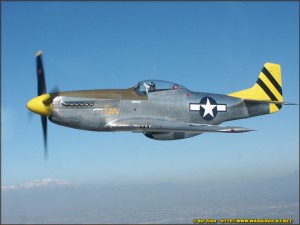
First Air-to-Air Flight
Used for giving Member Supported Flights to Museum Members, both Mustangs are quite the usual sight, and you can quite often hear their beautiful Merlin engines start up when walking around the museum on a standard weekend. It was a monthly event in 2004 that the opportunity came up for an air-to-air flight. Id’ be flying in the backseat of a World War 2 era North American SNJ Texan (The Naval version of the famous T-6 Texan) shooting out the canopy window. After taking off and cruising around in the SNJ, the P-51 Mustang ‘Spam Can’ caught up with us, and we started our left hand turns so I could get photos. It was a sight I won’t ever forget, seeing that P-51 Mustang along side us in all it’s prime. While I’d go on to have many more air-to-air adventures, only two moments stand out above all the rest and this was for sure the top one. The images from this shoot were also the first photos I ever had published, and on the cover of a magazine at that!
Throughout the years to come, I had many more opportunities to take photos of various P-51 Mustangs at airshows all over Southern California as I started to expand my range of airshows I attended.  Typically, over half of the airshows in a standard year would have at least one P-51 Mustang in attendance, many times also one of the performers of the show. I can’t even begin to count the different P-51s I’ve seen over the years. In 2010 the Planes of Fame Airshow featured the P-51 Mustang as the star of the show, and the call went out for many Mustangs to attend. They arrived in bunches, and soon the show had a massive gaggle of P-51 Mustangs. the highlight of the show for sure was the flight of over 10 P-51 Mustangs in the air in a long formation. Mustangs took to the skies all day long, quite the thrill for Mustang lovers! The 2010 Airshow included quite the lineage as well, with A-36 Apache, P-51A, P-51C, P-51D, and P-51H model Mustangs!
Typically, over half of the airshows in a standard year would have at least one P-51 Mustang in attendance, many times also one of the performers of the show. I can’t even begin to count the different P-51s I’ve seen over the years. In 2010 the Planes of Fame Airshow featured the P-51 Mustang as the star of the show, and the call went out for many Mustangs to attend. They arrived in bunches, and soon the show had a massive gaggle of P-51 Mustangs. the highlight of the show for sure was the flight of over 10 P-51 Mustangs in the air in a long formation. Mustangs took to the skies all day long, quite the thrill for Mustang lovers! The 2010 Airshow included quite the lineage as well, with A-36 Apache, P-51A, P-51C, P-51D, and P-51H model Mustangs!
After the first air-to-air flight with the P-51 Mustang, I continued to occasionally have the opportunity to photography Mustangs all over Chino and Riverside. 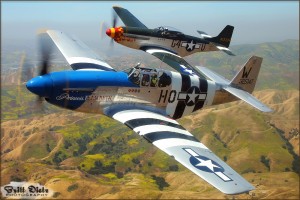 Be it in formation with aircraft of a small gaggle of Mustangs on their own, I’ve been able to photograph several different types of Mustangs. Some of my favorite air-to-air photoshoots have included P-51 Mustangs; in 2006, the Planes of Fame Air Museum sent up a historical formation of aircraft that spanned only 20 years, which included a P-51 Mustang and the eventual jet product of the North American Aviation company, an F-86 Sabre. It was a wonderful thing to see in person, so much history in one flight! The Museum’s Wee Willy II was the P-51 for that flight. In May of 2010, I had the chance to photograph a beautifully restored P-51C Mustang and a P-51D Mustang together over Chino. It was quite the sight to see flying alongside us, especially when they both banked away one at a time!
Be it in formation with aircraft of a small gaggle of Mustangs on their own, I’ve been able to photograph several different types of Mustangs. Some of my favorite air-to-air photoshoots have included P-51 Mustangs; in 2006, the Planes of Fame Air Museum sent up a historical formation of aircraft that spanned only 20 years, which included a P-51 Mustang and the eventual jet product of the North American Aviation company, an F-86 Sabre. It was a wonderful thing to see in person, so much history in one flight! The Museum’s Wee Willy II was the P-51 for that flight. In May of 2010, I had the chance to photograph a beautifully restored P-51C Mustang and a P-51D Mustang together over Chino. It was quite the sight to see flying alongside us, especially when they both banked away one at a time!
 But the best thrill of them all, was getting to fly in a P-51 Mustang. I’d always wanted a flight, but was in no hurry to get one as I’d rather be taking photos alongside the Mustang given the chance. But deep down, of course I wanted a flight in my favorite propeller fighter!
But the best thrill of them all, was getting to fly in a P-51 Mustang. I’d always wanted a flight, but was in no hurry to get one as I’d rather be taking photos alongside the Mustang given the chance. But deep down, of course I wanted a flight in my favorite propeller fighter!  The opportunity presented itself after one particular event. Funny enough, the pilot of the first air-to-air shoot I ever did with the P-51 Mustang would now take me up in a P-51! The P-51 that I’d fly in would be the P-51D Mustang known as Wee Willy II. Climbing into the cockpit of the P-51, there’s not much room for a passenger, especially if you’re 6 foot 4 inches like myself. During wartime, there was no second passenger seat in the Mustang, instead there was massive radio equipment which was needed to keep in contact. But, as with most things in technology, as time went on all that massive amount of radio equipment got smaller and smaller, and soon they didn’t need it at all in favor of smaller installable units that could be put into the instrument panels. So, with all that massive amount of radio equipment gone, it opened up some room behind the pilot… perfect for a small second seat. It’s pretty confined, however, and I couldn’t imagine going on a multi-hour flight anywhere in the back of a P-51 and being comfy. But the fact you’re flying in a P-51 helps to ignore that little fact.
The opportunity presented itself after one particular event. Funny enough, the pilot of the first air-to-air shoot I ever did with the P-51 Mustang would now take me up in a P-51! The P-51 that I’d fly in would be the P-51D Mustang known as Wee Willy II. Climbing into the cockpit of the P-51, there’s not much room for a passenger, especially if you’re 6 foot 4 inches like myself. During wartime, there was no second passenger seat in the Mustang, instead there was massive radio equipment which was needed to keep in contact. But, as with most things in technology, as time went on all that massive amount of radio equipment got smaller and smaller, and soon they didn’t need it at all in favor of smaller installable units that could be put into the instrument panels. So, with all that massive amount of radio equipment gone, it opened up some room behind the pilot… perfect for a small second seat. It’s pretty confined, however, and I couldn’t imagine going on a multi-hour flight anywhere in the back of a P-51 and being comfy. But the fact you’re flying in a P-51 helps to ignore that little fact.
After strapping in and putting headphones on, we taxied out to the runway, and after getting clearance from the tower,  we lined up for the take-off. The Mustang’s speed was pretty quick, it wasn’t long after the Mustang started to roll that I felt the tail rise up, and soon the two main landing gear in front leave the earth. And then, we were airborne heading into the heavens with great speed, leaving the runway behind us. The first part of the flight would be to perform a little demo for all the people at the Air Museum (since it was a monthly flying event). After a short few passes over the museum and briefly meeting up with the Museum’s Lockheed P-38 Lightning to fly in formation for a last pass, it was time to go off and have some fun. First on the agenda was to head towards Saddleback Mountain and continue beyond it. We found ourselves over the former MCAS El Toro base, which was the first time I’d seen the base (other than driving past it) since the last El Toro Airshow in 1997. It was as if I’d gone full circle, going back no to my roots! After flying around the base for a small orbit, we continued on flying around much to the delight of some of the people we’d pass on the ground who’d wave up at us. Must have been fun to see a P-51D Mustang come out of nowhere and fly around!
we lined up for the take-off. The Mustang’s speed was pretty quick, it wasn’t long after the Mustang started to roll that I felt the tail rise up, and soon the two main landing gear in front leave the earth. And then, we were airborne heading into the heavens with great speed, leaving the runway behind us. The first part of the flight would be to perform a little demo for all the people at the Air Museum (since it was a monthly flying event). After a short few passes over the museum and briefly meeting up with the Museum’s Lockheed P-38 Lightning to fly in formation for a last pass, it was time to go off and have some fun. First on the agenda was to head towards Saddleback Mountain and continue beyond it. We found ourselves over the former MCAS El Toro base, which was the first time I’d seen the base (other than driving past it) since the last El Toro Airshow in 1997. It was as if I’d gone full circle, going back no to my roots! After flying around the base for a small orbit, we continued on flying around much to the delight of some of the people we’d pass on the ground who’d wave up at us. Must have been fun to see a P-51D Mustang come out of nowhere and fly around!
After flying around a bit more, I got to experience another fun thrill, a victory barrel roll!!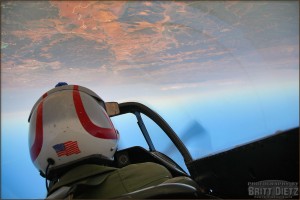 Now, I am by no means a Roller Coaster fan, so the mere fact that I wanted to do this was more adrenaline from the flight than my own mind thinking. After gaining some speed and putting the Mustang into a climb to get some altitude, I got the final ‘ready?’ from the pilot, and in what seemed like seconds we dropped the nose to gain some speed and the world went upside down in a full circle to come back to it’s original location. It was only a mere second that we were inverted, but it was quite the thrill! I’m glad I was able to both enjoy the roll and snap some shots of the view, a photo I’ll cherish forever! Not every day that someone can say they were in a P-51 Mustang when it did a barrel roll!
Now, I am by no means a Roller Coaster fan, so the mere fact that I wanted to do this was more adrenaline from the flight than my own mind thinking. After gaining some speed and putting the Mustang into a climb to get some altitude, I got the final ‘ready?’ from the pilot, and in what seemed like seconds we dropped the nose to gain some speed and the world went upside down in a full circle to come back to it’s original location. It was only a mere second that we were inverted, but it was quite the thrill! I’m glad I was able to both enjoy the roll and snap some shots of the view, a photo I’ll cherish forever! Not every day that someone can say they were in a P-51 Mustang when it did a barrel roll!
From there it was a nice flight back to Chino Airport, passing over a few other areas and giving a nice hello to the peak of Saddleback where several hikers were waving. Before I knew it, it was all over just as fast as the Mustang lifted off the ground. Looking back, it was such a rush and the excitement was so great that I feel the flight only lasted a few seconds rather than the actual 50 minute flight I got! I’m very thankful for the memories of this wonderful flight, and hope to one day get to experience it again!
 The North American P-51 Mustang will always hold a special place with me as one of my favorite aircraft of all time, right up there next to my other favorite fighter, the Boeing F/A-18 Hornet which I will feature in another blog post in the future. If you’d like to see a P-51 Mustang up close, there’s probably one closer to you than you think! If you live in the Southern California area, I highly recommend you check out the Planes of Fame Museum at Chino airport, you never know just how many P-51 Mustangs they might have! It’s worth the drive to head out and see one of the greatest military aircraft of ALL time!
The North American P-51 Mustang will always hold a special place with me as one of my favorite aircraft of all time, right up there next to my other favorite fighter, the Boeing F/A-18 Hornet which I will feature in another blog post in the future. If you’d like to see a P-51 Mustang up close, there’s probably one closer to you than you think! If you live in the Southern California area, I highly recommend you check out the Planes of Fame Museum at Chino airport, you never know just how many P-51 Mustangs they might have! It’s worth the drive to head out and see one of the greatest military aircraft of ALL time!
-

-

-
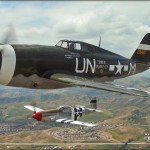
-

-

-

-

-
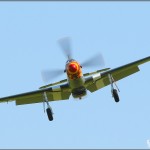
-

-
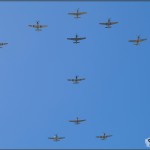
-
P-51 Mustang Gaggle from the 2010 Planes of Fame Airshow
-

-
